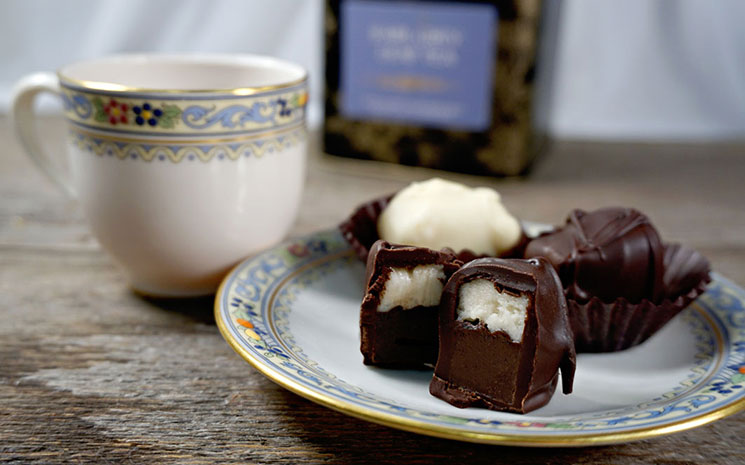
Know Your Chocolates: Milk, Dark and White
What’s the difference between milk, dark, and white chocolate?
We get variations on this question *a lot*. Some customers ask purely out of curiosity. Others ask with a hint of worry in their voice, as if preferring one kind of chocolate over another says something about them as person. Maybe they’ve heard or read reviews about what constitutes “real chocolate”: which is better for you, which is more sophisticated—that sort of thing.
Yes, chocolate can be described like wine (think “smoky undertones” or “vibrant cherry notes”). It’s also true that there are myriad subtleties in chocolate—if you want to take that deep dive. One thing Dean likes to do when giving a chocolate truffle-making class is line up different chocolates from around the world and give people a chance to taste them side by side. That way, the hints, and varieties of spice in the chocolate are easier to detect—just like wine.
For most of us, it really boils down to this: We know a good chocolate when we taste it. Whether you have a strong preference for a certain flavor or you’re in the “I love it all!” camp, we’re with you. Here’s a quick rundown on what differentiates milk, dark, and white chocolate.
Milk Chocolate
Some people call this “regular” chocolate. It’s probably what you grew up eating. Milk chocolate generally has a cocoa content of 25% to 40%. Dean’s Sweets milk chocolate is 32%, which means there’s 32% refined cocoa (a combo of cocoa butter and cocoa mass naturally produced by the cocoa plant) and 68% of everything else: sugar, milk, additional cocoa butter, and so on.
If you’re out and about and you see a milk chocolate with a higher percentage of cocoa (say 38%), that just means it’s a slightly darker milk chocolate, veering toward semi-sweet.
Dark Chocolate
The modern buzz around dark chocolate started late in the 20thcentury, with loads of scientific research about its many health benefits. Even its earliest form—it was first developed in South America nearly 4,000 years ago—was considered more of a medicine than a treat.
Dark chocolate has a higher percentage of refined cocoa than milk chocolate, ranging anywhere from 50% to 100% (100% isn’t just reserved for baker’s chocolate anymore). At Dean’s Sweets, we use a combination of 56% semisweet chocolate for our ganache—the center of the chocolate—and 70% bittersweet for the couverture, or the outside of the truffle, caramel, or buttercream.*
(*Sneak peek: We’re experimenting now with an 80% dark chocolate. Stay tuned for the results of our intensive R&D!)
White Chocolate
We’ve always admired the Swiss food scientist who, while working for Nestlé in the 1930s, first coined the term “white chocolate.” It’s brilliant marketing—considering the very yummy confection isn’t actually chocolate at all.
White chocolate contains a mix of sugar, cocoa butter, milk products, and vanilla, with no cocoa solids, meaning it’s not strictly chocolate. But it’s a still wonderful addition to the dark and milk chocolate options. At Dean’s Sweets, we offer white chocolate as an accent to our other, darker chocolates. Like our new London Fog truffle, which combines Earl Grey tea with vanilla buttercream dipped in a white (or dark) chocolate couverture. We also highlight the white in many of our shaped chocolates.
That gives you a basic overview of each type of chocolate. As for where we get our chocolate? That might be the most important ingredient of all!
Why We Use Belgian Chocolate
Since 2004, the chocolate we’ve used in our truffles, caramels, and other confections has been sourced from the world famous Callebaut Chocolatier—founded in Belgium in the late 1800’s.
Belgian chocolate is produced from cocoa beans from three countries: Ivory Coast, Ghana, and Ecuador, giving it a balanced flavor that our customers have come to love. We’ve also incorporated more sustainable varieties—including organic and fair-trade chocolate—while still maintaining that delicate balance.
The reasons we’ve stuck with Callebaut are simple:
- Depth and quality (without excessive fruity or flowery notes)
- It pairs well with so many flavors, from champagne to maple syrup
- Its nut-free products help us ensure the safety of our customers
Another question we’re often asked is whether we still enjoy chocolate after 16 years in the chocolate-making business.
Umm… Yes!
We love chocolate in all its many forms. Dark, milk or white; paired with fruit or scotch; after dinner or before: When it comes to chocolate, there is no wrong answer.
Photo: Jazmin Knapp